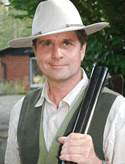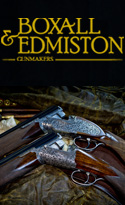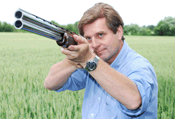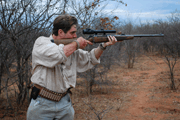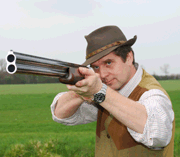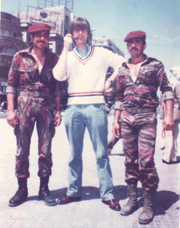Clays For Game Shooters
Those who are serious about improving their shooting, not to mention having some serious fun, should consider clay pigeon shooting too. One can simply book a lesson at a shooting school (always a good place to start), one can join a local clay club, or, one can attend local shoots or others listed in the shooting press. Many country shows now have clay shoots attached to them, most famously, the CLA Game Fair (to which any keen shot is well advised to bring a gun and plenty of cartridges).
There is also the exciting possibility of putting a team together for a charity shoot, creating your own clay shoot, or booking a slot at a major event like the English or British Sporting Opens, or, British Side by Side Championship (usually held at Broomhills Shooting Ground). There is no shortage of clay shooting opportunity in these isles. In fact, clay shooting is one of our most popular participatory sports albeit one that seems significantly censored in the sporting pages of Grub Street. George Digweed MBE has won no less than 16 world championships, Richard Faulds MBE won gold at the Sydney 2000 Olympiad in the ‘Double Trap’ discipline.
There are so many varieties of clay shooting, it can be quite a culture shock to a live quarry shot when he or she first starts to explore them. Trap shooting – where all birds are launched forward in a predetermined arc, and where you stand on one of 5 firing positions 16 yards or so behind the firing point – is the oldest form. Domestic Trap shooting is either DTL (Down the Line) or Double Rise. There are faster, more challenging, international disciplines too including OT (Olympic Trap) and Double Trap. All the trap sports evolved from live pigeon shooting which still provides clay shooting with some of its terminology. ‘Pull!’, the clay shot’s call for a target, relates to the string being pulled on a box trap with a real bird in it. ‘No Bird’, pronounced after a clay breaks as it comes from the trap or is otherwise mis-presented, is derived from the declaration that used to made when a live bird was disinclined to fly out of the box to meet its fate.
Skeet shooting is a rather different game, but one ideally suited to game shooters. It was developed circa 1914 by two American grouse shots, Messrs. Foster and Davies, as a means of off season practice. It involves a relatively compact, semi-circular, shooting layout with two traps – the High House and Low House. There are seven or eight shooting stations depending on the rules one is shooting by. The original idea, which holds true, is to shoot at all the angles a walked up grouse hunter might meet in the field. Skeet may be shot gun up or down if English or US rules pertain and is not only an addictive sport but fabulous practice for game shooting if shot gun down. The name, by the way, comes from the Norwegian word for shooting.
Sporting is the most popular form of clay busting in Britain. It comes from the realistic practice developed at Victorian and Edwardian shooting schools. It evolved into a sport in its own right in the 1920s after Nobel Industries produced a booklet entitled ‘The Versatile Clay Bird’ based on practice at the West London Shooting Grounds. The first British Championship was held in 1925 at the Albermarle Shooting School near Wimbledon. Sporting clays was exported to the States in the 1980s where it also thrives. The rough idea is that the ‘birds’ (usually presented in pairs) should simulate quarry species. Thus, one can get ‘driven,’ ‘rabbit,’ and ‘teal’ stands amongst many others. Competition and practice sessions may be held over anything from 20-120 birds, but 40, 50, 60 and 100 bird shoots predominate.
Hopefully, you have now been tempted to have a go at clay shooting (assuming that you do not shoot clays already). There are some questions to consider. First, is a game gun suitable for clay shooting? As far as skeet and sporting are concerned, any double barrelled game gun will do (and, don’t forget, you may find special competitions or classes for side by side guns). Ideally, though, I would say the most efficient tool for the job would probably be a 12 bore 30” barrelled multi-choked over and under. Machine made 28” barrelled guns are not quite as pointable or precise and this might become an issue at sporting which has evolved to become ever more challenging with ever longer target presentations. That said, I’ve managed some perfectly respectable scores with an 1880s Holland & Holland 16 bore hammer gun; one can have a lot of fun shooting clays with vintage guns. 32” over and under guns are experts tools, in experienced hands, they make some clays significantly easier and might do double service in Devon on high birds.
If you want to buy a gun for sporting and skeet, you might also consider a light recoiling semi-auto which might also be used in a pigeon hide or wildfowling (Beretta, Benelli, Browning and Fabarm all make excellent autos). As for choke and cartridges, don’t obsess. Start with quarter and half choke in a 12 bore double (assuming you can change chokes), or quarter, quarter. Don’t become a nervy choke changer. What about cartridges? If you are shooting a double gun, go for a light 24 gram 7 ½ load such as the Lyalvale Express HV (which I have also found an especially good side by side clay cartridge). Semi-automatics may require 28 grams to be reliable whatever manufacturers claim. Stick to 7 1/2s and don’t worry about it again. For 20 bores, I advise 24 gram 7 1/2s choked quarter half.
How does clay shooting differ from game shooting? In the simplest terms, it is more deliberate and requires more preparation [see box]. All the same principles apply, however, not least, safety. You should always carry your gun open and unloaded. Preferably, it should be slipped from stand to stand. Before loading on a designated position and at the designated time, check for obstructions. When you turn to leave the firing point, check your gun is unloaded and unobstructed. As ever, treat all guns as loaded and don’t point them at something you don’t intend to destroy. Clay shooting is a very safe sport, and clay shooters will pull each other up for even slight infringement of the rules.
As for basic technique, you must keep your weight forward (without leaning so far forward that it impedes body rotation), you must keep your head down and your eyes glued to the bird, and you must keep moving once you have fired. The follow through is all important. You must learn to read your birds and put as much effort into preparation for the shot as shooting itself. At sporting, always ask yourself where the bird is coming from and what it is doing. Is it deceptive? Is it wind affected? Is it slowing, dropping or going off line? Identify a tree or branch where you first see the clay if you can. Also consider what sort of target you are facing, clays come in three sizes (standard, midi and mini) and you may encounter battues and rabbits too.
Common errors include rushing to a stop and shooting behind and over because one lets the weight come back and the head rise during the swing. Midis and battues tend to be deceptively fast – initially at least. My usual advice on battues is 50% more than you think and forget about any curve in line. On quartering birds, I often say shoot the bottom front edge (there is often a tendency to shoot over quartering birds and, sometimes, in front). For teal, I advise shooting gun up and without hesitation. Rules permitting, mount the gun on the intended breaking point and wind back half way back down the predicted line. Call for the bird with gusto and shoot it decisively. Rabbits are often missed over the top (so shoot the bottom edge). And, if clay bunnies give you particular nightmares and all else fails try squinting an eye as you take the shot. On high birds, you’ll probably be behind, but you may be off line as well (just as with pheasant).
There is even more talk about forward allowance amongst clay shots than game shots, but, we’ll continue to keep it simple. If you shoot consciously, take your muzzles to the back of the bird and without hesitation or delay push through with good upper body rotation and fine control from the front hand. If you prefer a more instinctive approach, prepare yourself well as described in the box and just put all your efforts into keeping your eyes on the bird and the gun moving smoothly. The Clay Pigeon Shooting Association tell you to go the bird, move with it, and “pull ahead”. Some talk of maintaining a lead consciously or unconsciously – keeping the muzzles in front of the bird from the start – but this can get unaided beginners and those with eye issues into a muddle. I don’t advise it without an instructor.
Let me end by noting that there is one exclusive form of artificial target shooting that I have not yet mentioned but which game shots might especially enjoy. Helice (French for propeller) also called ZZ (Zinc Zurito) simulates live pigeon shooting but replaces the pigeon with a plastic whirly-bird rather reminiscent of the toys one used to get in cereal packets. The shoots – and they tend to be relaxed, friendly, and well organised – are set up much like a live pigeon match. You go to the firing point alone face five traps each with an oscillating electric motor with the target placed upon its spindle. Having pronounced that you are ‘Ready’, you call for the bird. Once you have shot the first you must gamble which of the remaining 4 traps will come into play. Its exciting, and, unlike most clay shooting, really tough to shoot even 10 birds straight. Try it!


